DIY Castile soap is one of the most inexpensive soaps you can make, perfect for beginners, yet it’s also one of the gentlest cleansers around. It’s a traditional olive oil soap recipe that’s easily one of my all-time favorites.
When my grandkids visit, I always have them use my Castile soap, because it’s so much kinder to their young skin than anything store-bought.
In fact, whenever someone I know has a new baby on the way, I make sure they get a big batch of this soap (without any essential oils). It’s perfect for delicate skin and saves them from buying pricey “baby soaps” that don’t come close to the real thing.

This is a cold-process solid soap bar, not to be confused with my liquid castile soap recipe which is also great for sensitive skin.
Watch how To Make Castile Soap
Castile Soap v Bastile Soap

Throughout its history, Castile soap is ordinarily made with 100% olive oil, which is one of the reasons it’s so pure and mild on the skin. However, in recent years, soapmakers have started making what has been coined ‘bastile soap’.
Bastile is your standard castile soap recipe but adulterated with a small quantity of other oils and/or cosmetic butter to enhance the skin-softening and nourishing qualities. Bastile is usually 80-95% olive oil, with the 20-5% additives being anything from shea butter to macadamia nut oil. Basically, whatever you wanna put in it!
There’s also another key reason you might favor making bastile soap over castile and that’s because bastile is a lot firmer than it’s purer sister soap. Castile can sometimes melt quite quickly when exposed to warm water. So, instead of lots of your lovely soap ending up down the sink, bastile affords you much more ‘lather time’, for the lack of a better phrase.
So, I thought it might be fun to share with you two of my favorite recipes, castile and bastile, all in one little blog post! Then, you can give both a try and see which one you prefer. So let’s kick things off with the traditional castile and come on to bastile in a little bit.
One thing I should note is that Castile has quite a rich, creamy texture to it. This is predominantly because of the high oil content and lack of other ingredients such as cosmetic butters. It almost feels like a lotion bar! Bastile is very similar, although a bit less creamy and easier to lather.
Ingredients In This DIY Castle Soap Recipe
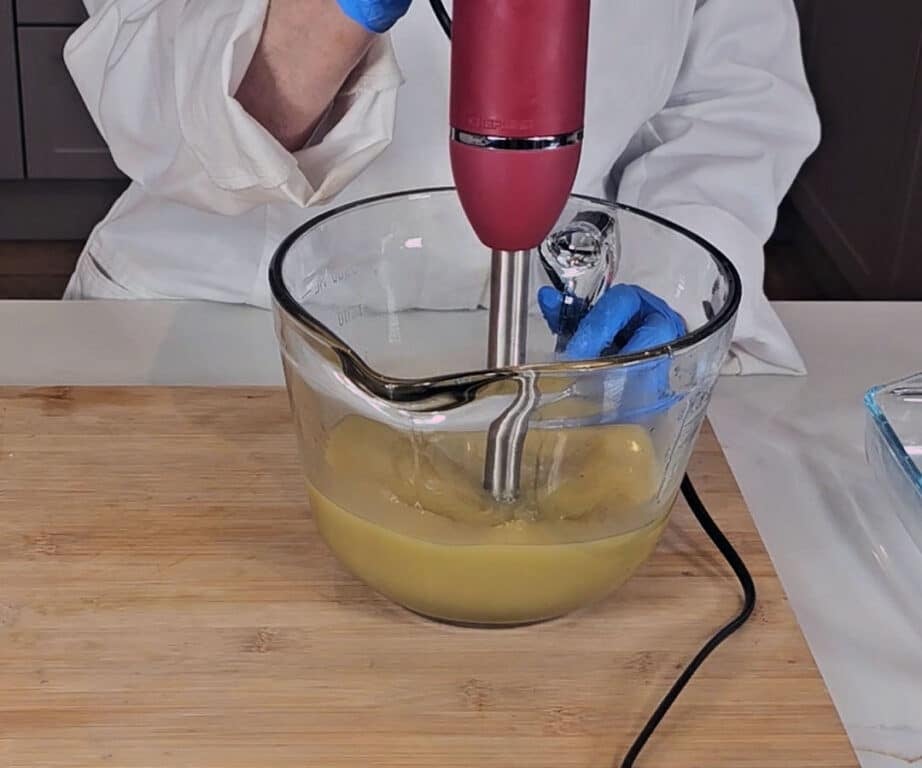
You’ll notice here that the amount of water I say to use in this recipe seems a little low. Usually, I opt for a ratio of 2:1 water to lye, but this recipe doesn’t even come close to that. In fact, if you run this recipe through a lye calculator, it might tell you to add a lot more water than I’ve recommended. However, you really don’t want to do this.
Do you remember when I said Castile is quite soft? Well, it also takes a very, very long time harden in the mold. By decreasing the amount of water we add, this recipe behaves much more like your standard soap recipe and you should be able to remove from the mold in about 24 hours to cut into bars. Business as usual!
For Little Ones & Babies
As I’ve already said, castile is great to use on your little ones, especially babies, as it’s the most gentle of cleansers you could possibly use besides water. If this is what you intend to use it for I recommend to omit any essential oil. Fragrance-free is always the best in terms of purity, especially for your little baby.
If your kids are a little older, you could get away with using a small amount of essential oil but I would still never use a synthetic fragrance oil on a child who’s skin, body and brain are still developing. There are still many unknowns when it comes to synthetics, particularly fragrance oils.
The research just isn’t there yet, and we have no idea how a synthetic agent such as fragrance oil can affect the developmental physiology of a young child. So, I would rather not risk it. If you want to use essential oil, I’d recommend ones that aren’t overly expensive or potent, such as lavender or sweet orange.
Unsuited To Fragrance Oils
Moreover, I find that this Castile soap recipe is just totally unsuited to fragrance oils in general. I really struggle to use them, as it makes the batter seize like crazy! Take my advice and just use an essential oil instead. Or, don’t use either.
As this recipe is so simple, with literally only olive oil besides our lye solution and essential oils, there’s very little to substitute here. Bastile soap allows for more freedom, so if you want to get creative scroll down to give that one a try instead.

My Castile Soap Recipe
As an Amazon Associate, I earn from qualifying purchases. If you buy via the links here I may earn a small affiliate commission at no cost to you, please read my affiliate disclosure.
Equipment
- Heat-Safe Mixing Bowl
- Plastic Containers to weigh out lye crystals
- Pitcher to make lye solutions
- Glass containers to weigh essential oil
Ingredients
- 80 grams Distilled Water
- 57.5 grams Soapmaking Lye (sodium hydroxide/lye crystals)
- 450 grams Olive Oil
- 15 grams Lavender Essential Oil
- 1 tbsp Nettle Leaf (ground, optional)
Video
Instructions
- Weigh the essential oil into a small glass container and set it aside for later use.15 grams Lavender Essential Oil

- Make sure you are making the soap in a well-ventilated area. Put on your gloves, eye protection, mask, apron, and long rubber gloves.

- Weigh the distilled water into a clean container. Never use a glass container as this is going to be holding the lye water. Lye can weaken glass so it can easily break. In a separate container, weigh your sodium hydroxide/lye crystals.80 grams Distilled Water, 57.5 grams Soapmaking Lye

- When you’re ready, carefully pour your lye crystals into the water. Never pour the water into the lye as this can create a violent reaction.Once the lye is in the water, start stirring it. Although you are wearing a mask, we still recommend turning your head and leaning away while stirring, so you do not breathe any of the fumes. As the water and lye mix this will result in a chemical reaction, and the lye water will increase in temperature and release toxic fumes.

- Stir until the lye crystals have dissolved and the water looks fairly clear. Now place to one side, somewhere well-ventilated but safe so that it will not be knocked over. Allow to cool to around 120f (49c) as we get on with our other steps.

- Place the olive oil into a large glass mixing bowl. Make sure the bowl is microwave safe, then pop it into the microwave and gently warm it to around 120f 49c)450 grams Olive Oil

- Check the temperature of the oils and the lye water. You can do this with a temperature laser gun or a jam thermometer. We want them both to fall between 120- 100 (49-38C). If they are still too hot, leave them to cool for a while longer. They do not need to be the same temperature, for example, the lye could be 120f and oils 110f, but it is best to keep them within 10 degrees of each other.

- Once you’re satisfied they’re balanced, carefully pour your lye solution into your oils. Before turning on the stick blender to mix the oils and lye, gently tap the stick blender against the bottom of your container. Continue tapping until all the air bubbles have been released.
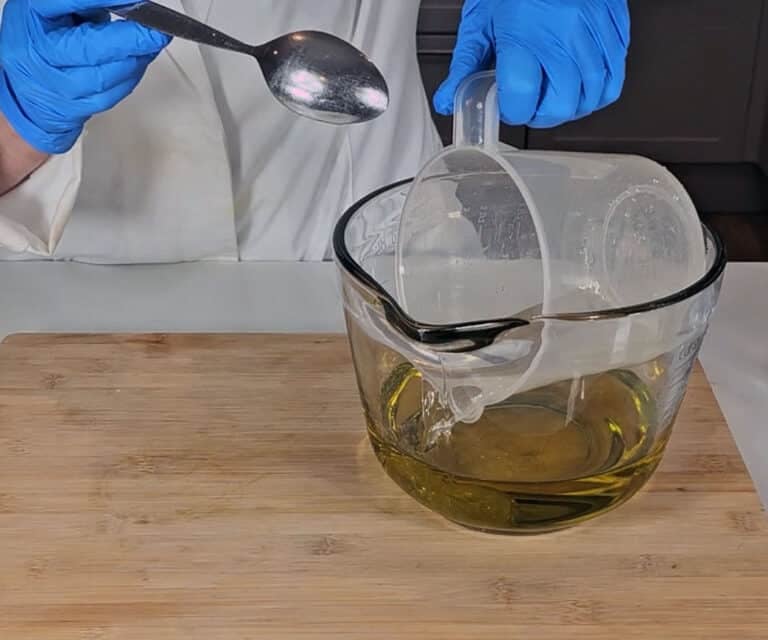
- Turn the stick blender on and blend the soap batter until you reach a light trace. You will notice immediately that the color of the oil has changed to a creamy, yellowish hue. This is called emulsion and is the precursor to trace.If you’ve made any other type of soap before, you may notice that this soap takes a lot longer to trace than others. This is fine and totally normal, just keep blending until you can pick up some of the mixture with a spatula, and ladle it back onto the surface of the batter. If it sits on top of the batter for a few seconds before submerging back in, then your soap batter has reached a trace.

- Now that we’re at trace, it’s time to add our essential oils. I always recommend getting the mold ready before adding the essential oils, as they can sometimes thicken the soap batter, meaning you have to work quickly to get it into the mold.

- After adding the essential oil, give the soap batter a good stir with the spatula or a few more blasts with the blender to ensure that it is fully dispersed. If you are adding a herbal powder you can also add and blend this in now. For half plain and half herbal, you will need to pour the plain ones first before blending in the herbs.1 tbsp Nettle Leaf

- Carefully pour the batter into your chosen mold. If you are using silicone molds like the ones we are using, remember to stand the mold on something solid so that you can move it if necessary. A chopping board or book usually works well. Give it a few light taps down to even the soap batter, or use a silicone spatula to level it out if needed. You can leave the top of the soap flat or add some texture with a spoon. Adding texture is a great way to conceal any uneven flaws and can make the soap interesting.
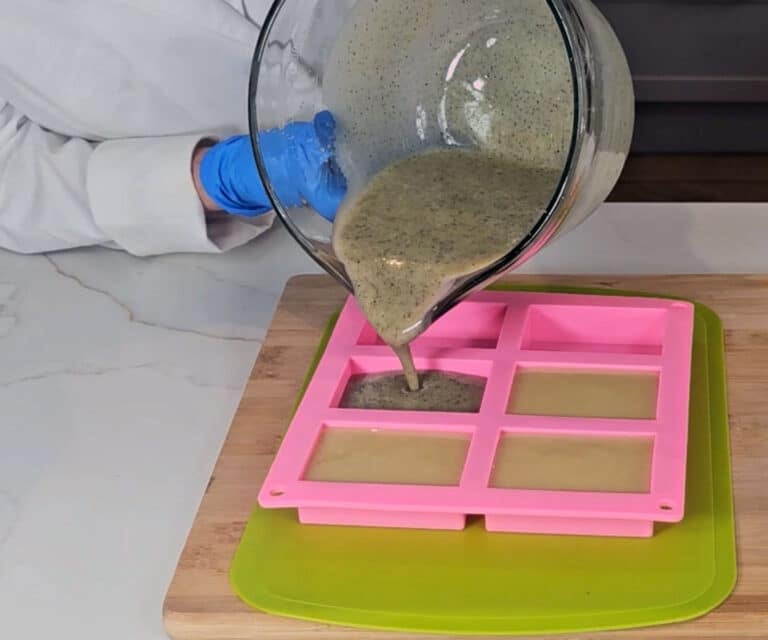
- We now need to leave this to saponify for at least 48 hours before we can remove it from the mold. I like to keep it well insulated during this period, so the gel phase is efficient. I do this by cutting a piece of cardboard to sit on top of the mold and then covering it with an old towel.

- Once our soap has fully saponified, and the sides of the mold come away easily from the soap, it’s okay to remove it from the mold. We find that castile soap takes longer to harden than most soaps, so be patient and don't panic if it takes a bit longer.If you have used a loaf mold, cut the soap into bars using a stainless steel knife or a soap cutter. You should be able to get between 6 bars from this batch, depending on the desired thickness.

- Leave the soap bars to cure for at least six weeks in a cool, dry place. The longer you leave castile soap to cure, it will produce a harder and longer lasting bar.Always check the PH before using it.
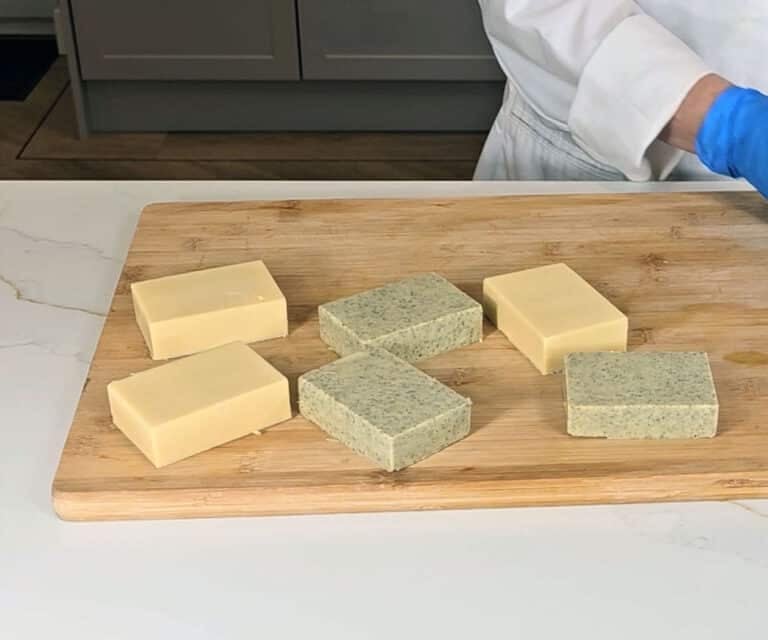
Notes
The Bastile Soap Recipe
Ingredients For a Full Soap Loaf

Lye Solution
- 171g Distilled water
- 114g Sodium hydroxide crystals/caustic soda
Oils and Butters
- 35.5g Essential Oil
- 765g Olive Oil
- 135g Shea Butter
Notes on ingredients
As I said earlier, bastile soap is much more versatile due to the inclusion of other oils besides olive. When substituting the shea butter, you can use any cosmetic butter you prefer. Cocoa, mango and illipe are all good alternatives to shea. If you like, you can substitute some of the shea for various base oils that you enjoy or want to try. Be careful to make sure that you have no less than 80% of your oils and butter mix to be olive oil, as otherwise you’re not really making bastile soap at all.
Important note! If you do intend to sub some of the ingredients, keep in mind that you will need to run it through the sap calculator in order to make sure you’re using the right amount of lye. Nonetheless, I would stick to the amount of water I suggest and always check the PH before using it.
Like with Castile, feel free to experiment with whatever essential oil blends that take your fancy. However, remember that if this is intended for young children, make sure not to use certain essential oils. If this soap is for a baby, you may want to avoid using any essential oil at all and keep it scent/fragrance-free for their super sensitive skin.
Method
Follow all the steps I’ve listed above for DIY castile soap, although you will need to melt the shea butter. You can do this by simply combining the shea and the olive oil in step 3. Ensure that the shea is fully melted, and the oil/butter and lye solution are at a balanced temperature of between 90-140F before combining.

Final Thoughts
So there we have it, how to make castile soap in two ways, that will cost you very little to make! This particular recipe is a great one to learn, simply because the ingredients are so easy to get your hands on and is always my go-to if I’m low on certain ingredients.
I’ve been perfecting how to make castile soap for years now, and I’ve only recently started using significantly less water. I have to say, I’ll never go back to the amount of water I was using before. If like me, you make a lot of soap, it’s really annoying having to wait around for liquidy batter to harden in the mold.
When I have a million and one different recipes I want to try, I just don’t want to wait around to use one of my molds again. I guess if you had a ton of molds it wouldn’t be so bad, but for someone who doesn’t make this to sell buying lots of molds is not a great investment.
My family absolutely loves this castile soap (which is great considering how it’s a lot cheaper to make than any other). I’ve absolutely committed it to memory now, and I encourage you to do so as well.
If you give this recipe a go, totally let me know how you got on. I love to hear all of your soaping stories, especially when something goes wrong so I can try and help you out. I also love hearing what fragrance and essential oil blends you use, it’s fun to experiment and find new amazing aromas!

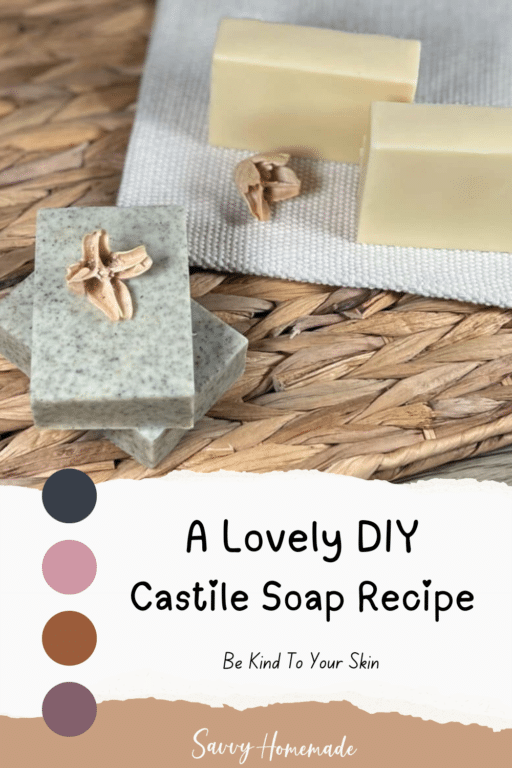
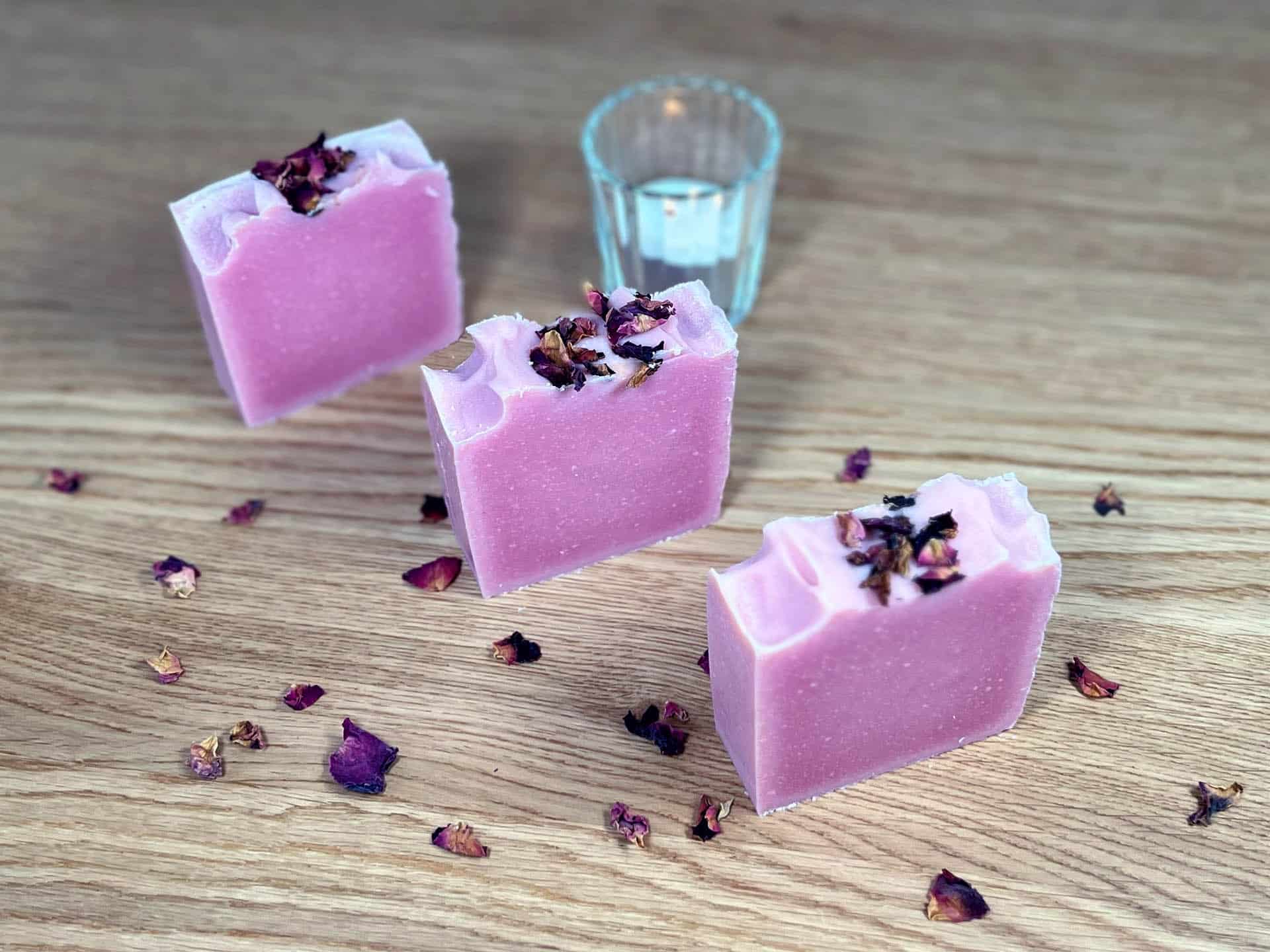
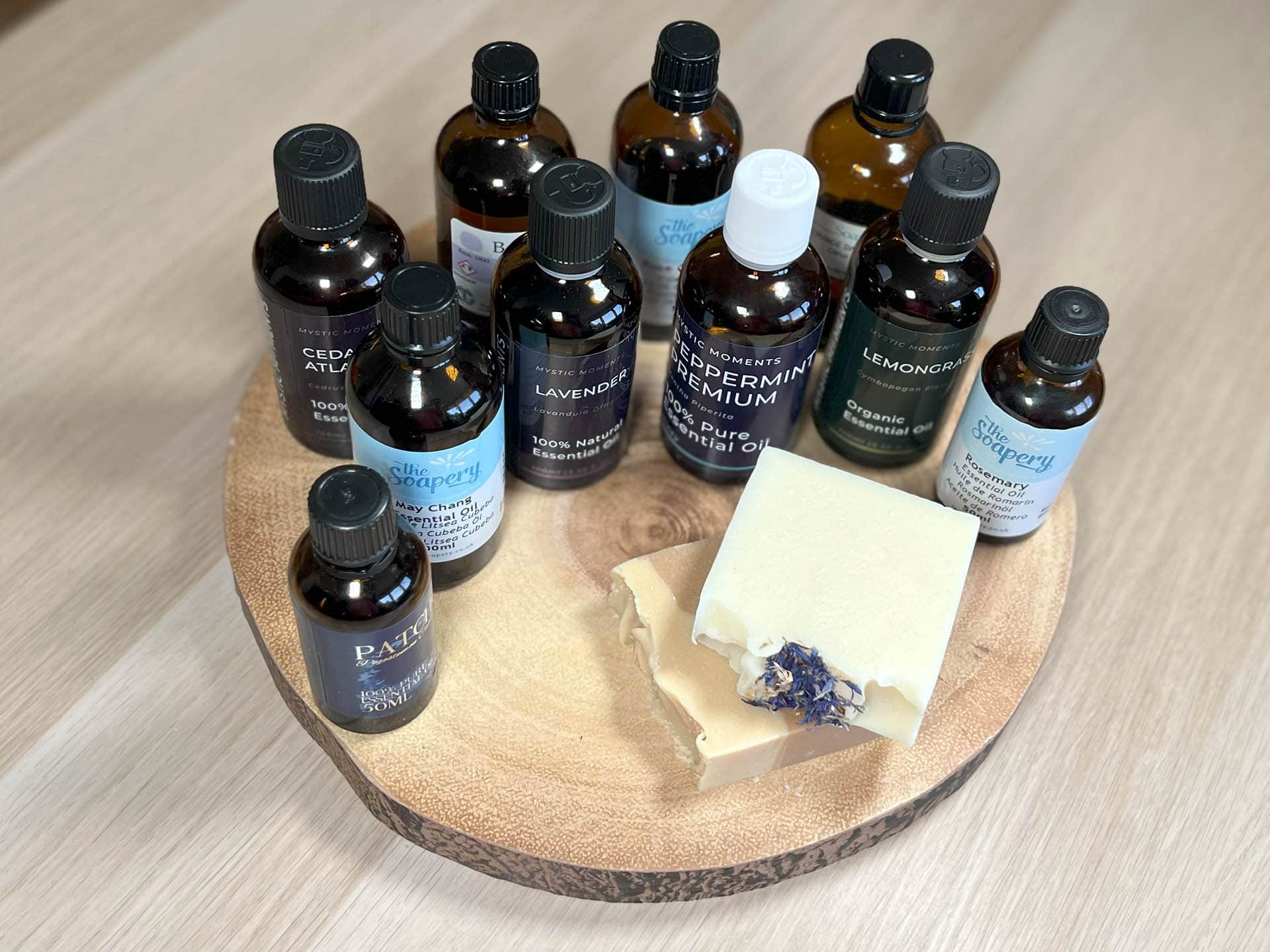
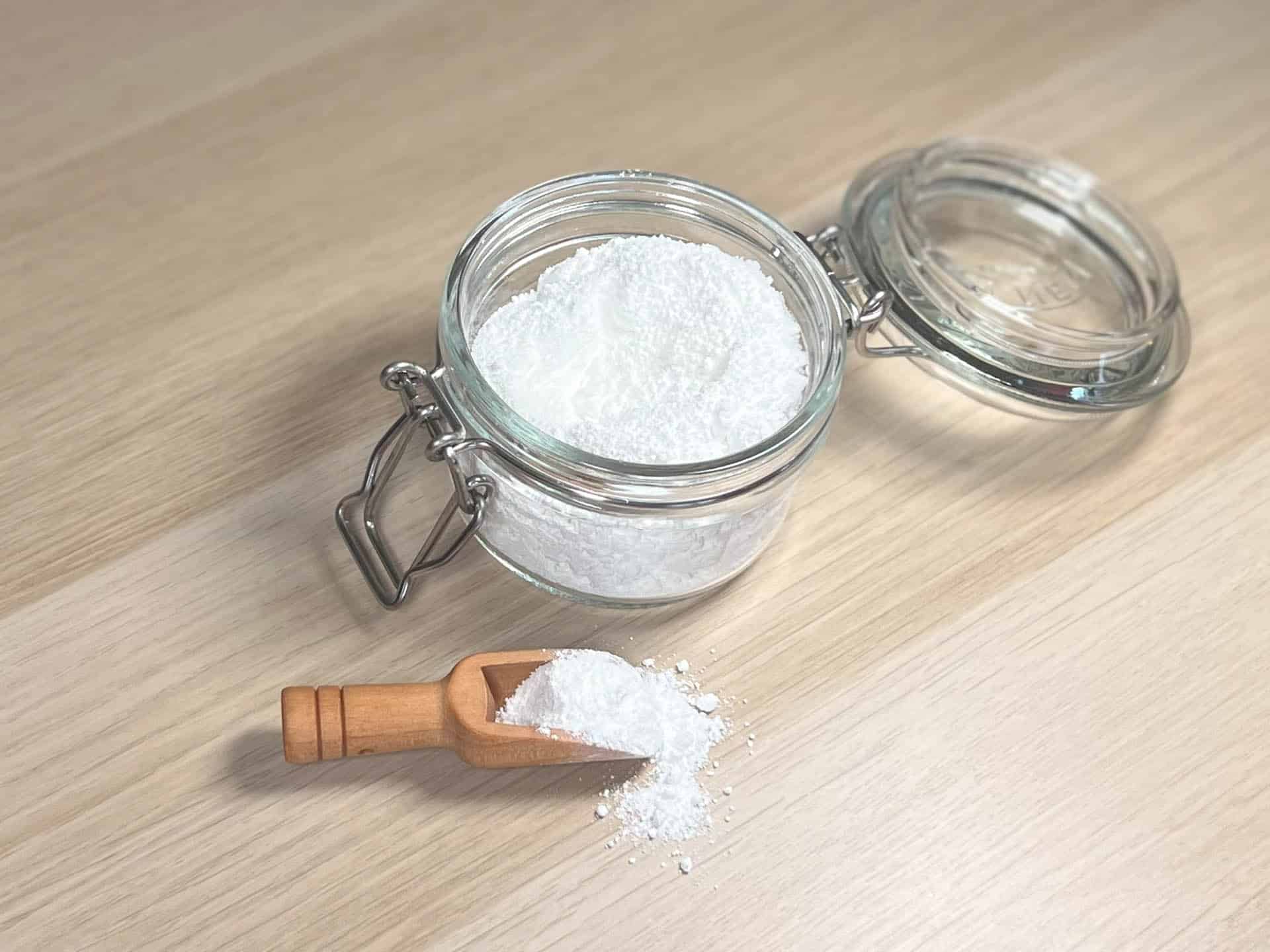
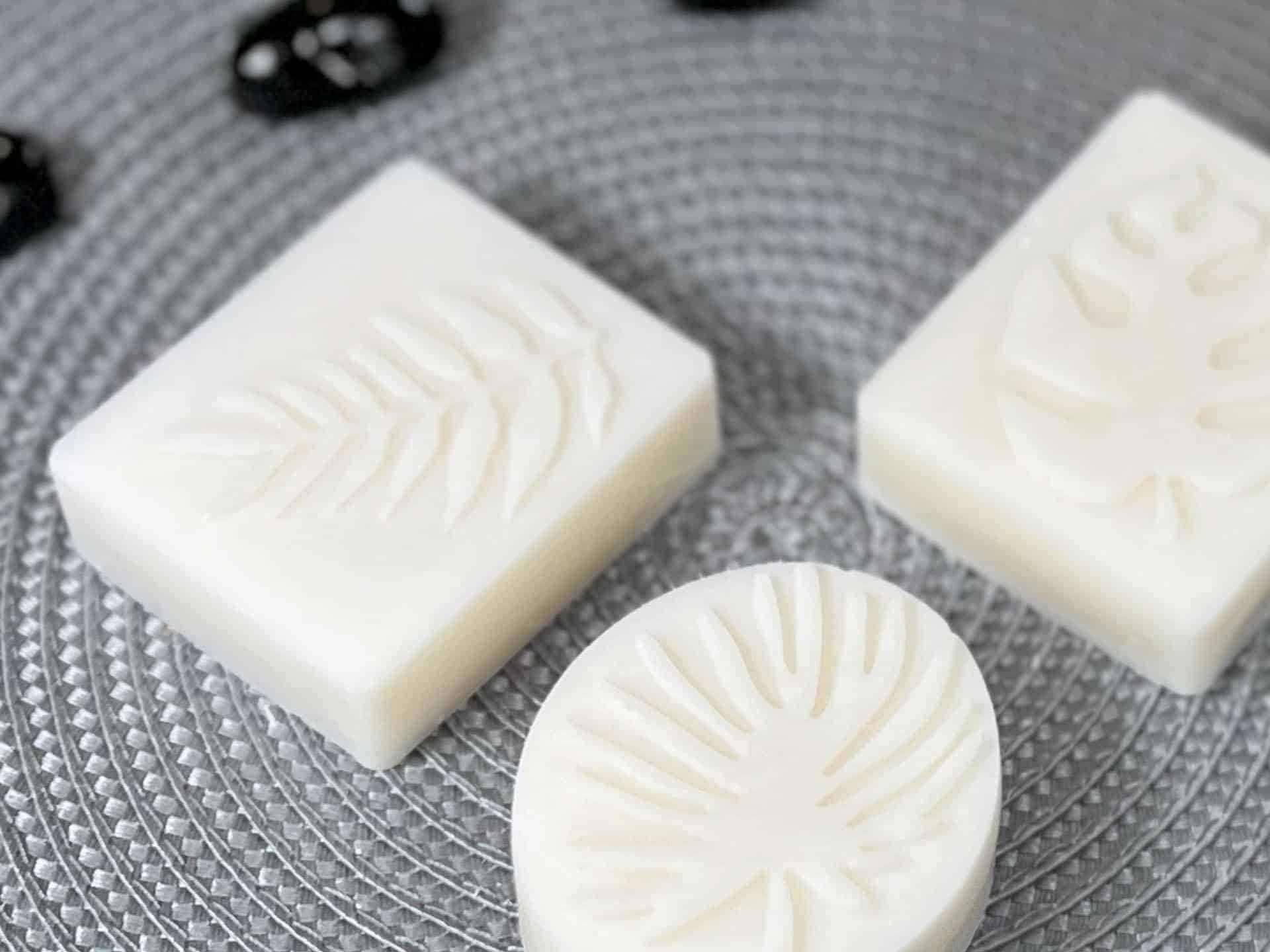


Hi Angela,
Can this Castile soap be made using hot process method?
P.S. I love your blog and your recipes.
Hi Maggie,
I don’t see why not! Just follow our method for hot process soap, using the ingredients on this page. However, I would take the water back up to 1:2 (so just double the amount of water). But otherwise you won’t have any problems, especially if you’re already experienced with hot process soap.
Very useful and informative pointers and tips on castile soap recipes.. great read.
Thanks for posting this! I did the bastile recipe, but changed it so it was 10% shea and 10% cocoa. I wanted it to be a little harder than castile. I ran it through a lye calculator and it still came out to 114, so I just used your water and lye measurements. It’s been about 24 hours and it’s soft to the point of still being a little liquid. It has been insulated the whole time. I’ll wait 48 and still leave the towels on, but somehow I suspect that this won’t set up. Is there anything I did wrong? Is there anything I should do now such as take the towels off perhaps?
Thanks! Helen
Hi Helen,
As long as your lye was not weak and you measured out everything correctly, it should harden up. I would take the towels off and let it get some air, I usually do this after 24hrs.
Your instructions are easy to follow and video let me know what size bowls needed I now feel confident to get started
thank you x
Hi Diane, that’s exactly what I was hoping for, best of luck with your soapmaking!
Thanks again and I will have to check out the soap calculator and formulation guide ?
Take care and I’m sure I will be needing your help again lol.
God Bless!
Hi again Angel!
I hope you’re having an amazing day! I wanted you to know that I made another batch of the castlie soap and this time I did as you said by insulating it and the soap turned out beautiful!!! I didn’t even have to wait the whole 24 hours before cutting. The soap harden up so beautifully I was able to remove from my silicone mold and cut within 12 hours ?
Thanks so much again, next time I’m looking forward to making your next soap recipe, the one with Shea Butter! I also subscribed to get your newsletters. Take care and God Bless!
That’s great news Ernestine, I’m so happy for you!
Once you’ve made a few soaps, turn your attention to the soap calculator and formulation guide where you can create your own recipes from scratch!
Thanks so much for replying back and for the positive feedback ? I’m going to give it another try and I will keep you posted.
Take care, and God Bless!
Hi Angela!
I am new to soapmaking and I found your website and I love your personality and how your recipes sounds really easy!
I made the Castile soap and I was very careful to follow your recipe. I let it sit in my silicone mold for 24 hours before cutting. The next day when I unmolded it, and begin to cut, the soap was pretty hard and as I cut into bars some of the soap crumble ☹️ I only used about 10 grams of lavender essential oil. Since I live in a humid environment I didn’t insulate my soap.
What could I possibly have done wrong? Thanks so much for your time and I can’t wait to hear back from you ? God Bless!
Hi Ernestine
Sorry that you had issues with your soap, unfortunately soapmaking is not an exact science, and many factors come in to play.
In your case, I would say that it sounds like you haven’t insulated it enough, but it could also point to having too much lye. This recipe can be a little more difficult as I’m reducing the water level. This is because castile soap is usually quite soft and takes a very, very long time harden in a mold. Next time try insulating and if you still have problems increase the water a little, as that will make it easier to work with.
Check the soap is ok with a PH strip, and if so you could use it for something like the Cleopatra’s Milky Cocoa Butter Bath Treats.
Above all don’t let this put you off soap making, as once you have more experience you will find it easy to overcome issues like this.
Hi Angela, I knew I was going to forget something from my question I already submitted. I don’t especially like the smell of olive oil, especially extra virgin. Will this soap have any of that olive oil scent if I make it without essential oils for fragrance? I would like to make it unscented if it won’t smell strange.
Thanks.
Thank you for this website. I have been making my own lotions and even a wonderful cream for muscle pain that actually works. Now it is time for me to delve into replacing my shampoo, conditioner and soaps. I would like to know if you have a tutorial for making liquid castile soap. I bought a bottle, but it is quite pricey, so I would love to make it myself.
Thank you so much for all your great information!
Diane
Hi Diane,
Thanks for your lovely comment! As for liquid castile soap, I haven’t done a lot of liquid soap recipes. It’s definitely something I want to get more acquainted with, so I’ll be posting on this subject sometime early this year. So watch this space on that one. Update: As promised here’s my liquid soap recipe and method.
As for the smell of your soap, without fragrance oil or essential oil, you may find that some of the smell of the olive oil does remain. However, you don’t need to make use of extra virgin olive oil if you don’t want to. Pomace Olive Oil is just as good, if not better for soap making. Another consideration you could make would be bastile soap. It’s very similar to Castile, but you can add extra oils. These extra oils could ‘dilute’ the smell of olive oil you find unpleasant.
I hope this helps and good luck with your soap making!
Hi there, thank you for this great information! I recently made a batch of cold process castile soap. It has been curing for two weeks. Is there a way to rebatch it to make it more of a bastile? Or would I have to add more lye/water solution and ‘start over’?
Thank you!
Hi Elizabeth,
You absolutely can. Take a look at my post The Pros, Cons and Method We Use For Rebatching Soap. It should give you some good advice on how to go about it if you haven’t rebatched before.
Hope this helps!
What is the cure time for these soaps
Hi Linda,
I would say around 4-6 weeks, but Castile and Bastile have a tendency to take longer sometimes. I’d leave it for 5, check to see the consistency (that is isn’t too soft) and give it a try.
Can i double the recipe without changing anything?
Hi Maryam,
Providing you double everything correctly, that should be fine. You’ll need a bigger mixing bowl though, which I’m sure you’ve already thought about.
Hope this helps!
I am new to soap making. Took a simple class locally to learn olive oil soap. They grow olives. I want to find a recipe for chocolate/ cocoa soap. I have purchased a 5 pound mold. When in Seattle they had wonderful smelling chocolate soap.
what is the shelf life for this castile soap? does this work as (pure) shampoo bar as well or there is a different recipe?
if essential oil will be added (future reference), how many drops is recommended for this recipe?
thanks~
Hi Shirley,
Soap shelf life is a little difficult to determine. After about a year you’ll start to notice the aroma has gone, the color has faded and the bar is often very dry (and hard). I wouldn’t keep soap longer than that.
As for the number of drops needed for soap, I really wouldn’t recommend using drops. As you notice my recipe calls for essential oil in grams. I wouldn’t be able to convert it for you in this context because there is no real standardized ‘gram to drop’ ratio, especially considering how different essential oils have different densities. Get yourself a jewelry scale, they’re super precise and really don’t cost very much at all. It’s the best way to measure small quantities of oil.
I hope this helps, and good luck with your soap making!